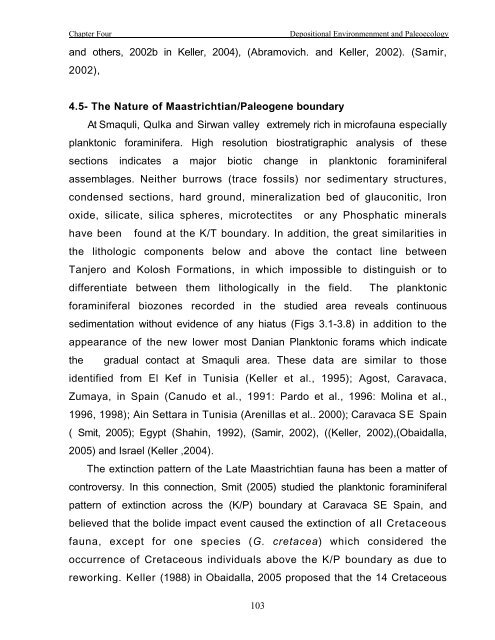biostratigraphy and paleoecology of cretaceous/tertiary boundary in ...
biostratigraphy and paleoecology of cretaceous/tertiary boundary in ...
biostratigraphy and paleoecology of cretaceous/tertiary boundary in ...
You also want an ePaper? Increase the reach of your titles
YUMPU automatically turns print PDFs into web optimized ePapers that Google loves.
Chapter Four<br />
Depositional Environmenment <strong>and</strong> Paleoecology<br />
<strong>and</strong> others, 2002b <strong>in</strong> Keller, 2004), (Abramovich. <strong>and</strong> Keller, 2002). (Samir,<br />
2002),<br />
4.5- The Nature <strong>of</strong> Maastrichtian/Paleogene <strong>boundary</strong><br />
At Smaquli, Qulka <strong>and</strong> Sirwan valley extremely rich <strong>in</strong> micr<strong>of</strong>auna especially<br />
planktonic foram<strong>in</strong>ifera. High resolution biostratigraphic analysis <strong>of</strong> these<br />
sections <strong>in</strong>dicates a major biotic change <strong>in</strong> planktonic foram<strong>in</strong>iferal<br />
assemblages. Neither burrows (trace fossils) nor sedimentary structures,<br />
condensed sections, hard ground, m<strong>in</strong>eralization bed <strong>of</strong> glauconitic, Iron<br />
oxide, silicate, silica spheres, microtectites or any Phosphatic m<strong>in</strong>erals<br />
have been found at the K/T <strong>boundary</strong>. In addition, the great similarities <strong>in</strong><br />
the lithologic components below <strong>and</strong> above the contact l<strong>in</strong>e between<br />
Tanjero <strong>and</strong> Kolosh Formations, <strong>in</strong> which impossible to dist<strong>in</strong>guish or to<br />
differentiate between them lithologically <strong>in</strong> the field. The planktonic<br />
foram<strong>in</strong>iferal biozones recorded <strong>in</strong> the studied area reveals cont<strong>in</strong>uous<br />
sedimentation without evidence <strong>of</strong> any hiatus (Figs 3.1-3.8) <strong>in</strong> addition to the<br />
appearance <strong>of</strong> the new lower most Danian Planktonic forams which <strong>in</strong>dicate<br />
the gradual contact at Smaquli area. These data are similar to those<br />
identified from El Kef <strong>in</strong> Tunisia (Keller et al., 1995); Agost, Caravaca,<br />
Zumaya, <strong>in</strong> Spa<strong>in</strong> (Canudo et al., 1991: Pardo et al., 1996: Mol<strong>in</strong>a et al.,<br />
1996, 1998); A<strong>in</strong> Settara <strong>in</strong> Tunisia (Arenillas et al.. 2000); Caravaca SE Spa<strong>in</strong><br />
( Smit, 2005); Egypt (Shah<strong>in</strong>, 1992), (Samir, 2002), ((Keller, 2002),(Obaidalla,<br />
2005) <strong>and</strong> Israel (Keller ,2004).<br />
The ext<strong>in</strong>ction pattern <strong>of</strong> the Late Maastrichtian fauna has been a matter <strong>of</strong><br />
controversy. In this connection, Smit (2005) studied the planktonic foram<strong>in</strong>iferal<br />
pattern <strong>of</strong> ext<strong>in</strong>ction across the (K/P) <strong>boundary</strong> at Caravaca SE Spa<strong>in</strong>, <strong>and</strong><br />
believed that the bolide impact event caused the ext<strong>in</strong>ction <strong>of</strong> all Cretaceous<br />
fauna, except for one species (G. cretacea) which considered the<br />
occurrence <strong>of</strong> Cretaceous <strong>in</strong>dividuals above the K/P <strong>boundary</strong> as due to<br />
rework<strong>in</strong>g. Keller (1988) <strong>in</strong> Obaidalla, 2005 proposed that the 14 Cretaceous<br />
103

















